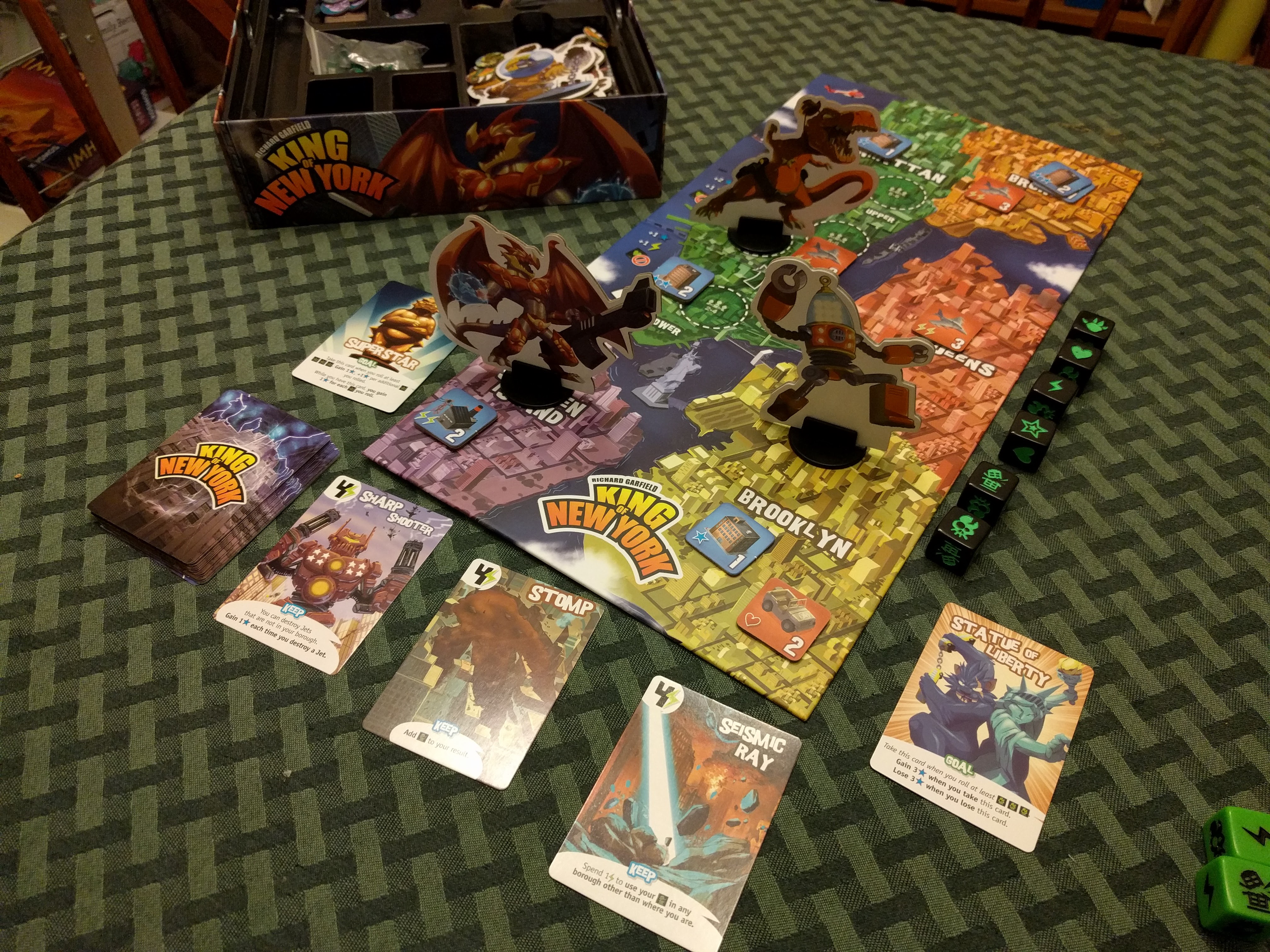Lately I’ve been noticing an increase of Ukrainian hackers trying to break into my site. So after increasing security accordingly, I caught sight of the date of my last post here, and thought, “Hm, perhaps they think this blog is up for grabs.” Which is a slightly long way of saying: Here come some new game reviews…
Designer: Richard Garfield
Artists: Sébastien Lamirand, Igor Polouchine, Régis Torres, Alexey Yakovlev
Publisher: IELLO
Players: 2-6
Playing time: 40 minutes
Age range: 10+

Back in *mumblemumble* 2013, I did a review of the original king-of-the-hill dice game, King of Tokyo. King of New York is an update of that by the same designer. Generally it’s the same game: 1 or 2 people try to hold territory against other players and score points for each round they remain there. Those on the hill can attack all the other players at once while the other players can only do damage against those the hill. The penalty for remaining on the hill is that you can’t heal damage via the dice, nor can you retreat until attacked. You can also collect energy (i.e., money) which you can use to buy action and upgrade cards. The player who reaches 20 point or outlasts everyone else wins the game.
King of New York adds a few new wrinkles to this basic formula. First, the “hill” is now Manhattan, instead of Tokyo. And it’s also broken into three sections: Lower, Midtown and Upper. When you enter Manhattan you begin in Lower Manhattan, and each round you manage to stay there, the higher you move up. Moving up gives you more points and also energy as well.
In King of Tokyo, non-“hill” players kept their monsters in front of them. In this game, you have the other boroughs of New York to move around in and conquer. In each borough (including Manhattan) are placed three stacks of building tiles which can be stomped on, giving you benefits such as energy, health and points. However, once a building is stomped, it gets flipped over and turned into military units which can attack you. Defeating those gives you further benefits and removes them from the board.
The dice have changed as well. The basic Attack, Energy and Health sides are still there, but gone are the numbers. They have been replaced by three new symbols: Destruction, Ouch! and Celebrity. Destruction is used to destroy buildings and units — match or exceed the number on the tile with Destruction symbols and it is destroyed. Ouch! activates the military. One Ouch! and the units in your borough attack you for one point of damage per tile. Two Ouch!s and the units in your borough attack everyone in the borough. Three Ouch!s and all the units in New York activate, plus you become the Defender of the City, giving you three extra victory points — at least, until someone else rolls three Ouch!s.
Celebrity only comes into play if you roll three in a turn. When that happens, you take the Superstar card. Thereafter, you gain a victory point for every Celebrity symbol you roll — again, until someone else rolls three in a turn and takes it from you.
So how does it compare with King of Tokyo? The three-stage hill is definitely more interesting, and the buildings and units give you a little more to do as the non-hill players (and can keep things tense for those in Manhattan — don’t want to roll those Ouch!s!). There is also the strategic element of moving around the boroughs to smash buildings and avoid the military units. That said, the Celebrity mechanic feels a little more tacked on — the payoff just doesn’t seem large enough.
Summing up, if you feel like you’ve played out King of Tokyo and want something with a little more going on with a similar theme, King of New York certainly worth checking out. However, I still prefer the pure simplicity of King of Tokyo — it’s much more of a basic beer-and-pretzels game — and am more likely to pull that off the shelf when I want to get some monster dice-rollin’ on.
Recommended.



Leave a reply